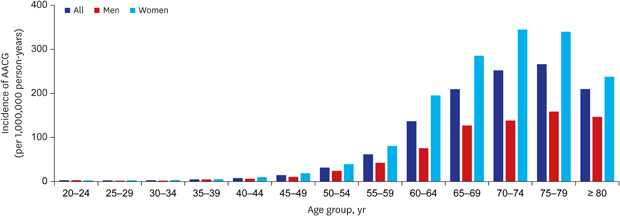1. Quigley HA, Broman AT. The number of people with glaucoma worldwide in 2010 and 2020. Br J Ophthalmol. 2006; 90(3):262–267.
2. Tham YC, Li X, Wong TY, Quigley HA, Aung T, Cheng CY. Global prevalence of glaucoma and projections of glaucoma burden through 2040: a systematic review and meta-analysis. Ophthalmology. 2014; 121(11):2081–2090.
3. Hu CN. An epidemiologic study of glaucoma in Shunyi County, Beijing. Zhonghua Yan Ke Za Zhi. 1989; 25(2):115–119.
4. Congdon N, Wang F, Tielsch JM. Issues in the epidemiology and population-based screening of primary angle-closure glaucoma. Surv Ophthalmol. 1992; 36(6):411–423.
5. Gillan SN, Wilson PJ, Knight DS, Sanders R. Trends in acute primary angle-closure glaucoma, peripheral iridotomy and cataract surgery in Scotland, 1998–2012. Ophthalmic Epidemiol. 2016; 23(1):1–5.
6. Teikari J, Raivio I, Nurminen M. Incidence of acute glaucoma in Finland from 1973 to 1982. Graefes Arch Clin Exp Ophthalmol. 1987; 225(5):357–360.
7. Chiu SL, Chu CL, Muo CH, Chen CL, Lan SJ. The prevalence and the incidence of diagnosed open-angle glaucoma and diagnosed angle-closure glaucoma: changes from 2001 to 2010. J Glaucoma. 2016; 25(5):e514–9.
8. Cheol Seong S, Kim YY, Khang YH, Heon Park J, Kang HJ, Lee H, et al. Data resource profile: the National Health Information Database of the National Health Insurance Service in South Korea. Int J Epidemiol. 2017; 46(3):799–800.
9. Park SJ, Choi NK, Park KH, Woo SJ. Five year nationwide incidence of rhegmatogenous retinal detachment requiring surgery in Korea. PLoS One. 2013; 8(11):e80174.
10. Park SJ, Choi NK, Park KH, Woo SJ. Nationwide incidence of clinically diagnosed retinal vein occlusion in Korea, 2008 through 2011: preponderance of women and the impact of aging. Ophthalmology. 2014; 121(6):1274–1280.
11. Park SJ, Choi NK, Seo KH, Park KH, Woo SJ. Nationwide incidence of clinically diagnosed central retinal artery occlusion in Korea, 2008 to 2011. Ophthalmology. 2014; 121(10):1933–1938.
12. Park SJ, Kwon KE, Choi NK, Park KH, Woo SJ. Prevalence and incidence of exudative age-related macular degeneration in South Korea: a nationwide population-based study. Ophthalmology. 2015; 122(10):2063–2070.e1.
13. Cho SC, Park SJ, Byun SJ, Woo SJ, Park KH. Five-year nationwide incidence of macular hole requiring surgery in Korea. Br J Ophthalmol. 2019; 103(11):1619–1623.
14. Kwon S. Payment system reform for health care providers in Korea. Health Policy Plan. 2003; 18(1):84–92.
15. Park BJ, Sung JH, Park KD, Seo SW, Kim SW. Report of the Evaluation for Validity of Discharged Diagnoses in Korean Health Insurance Database. Seoul: Seoul National University;2003.
16. Ivanisević M, Erceg M, Smoljanović A, Trosić Z. The incidence and seasonal variations of acute primary angle-closure glaucoma. Coll Antropol. 2002; 26(1):41–45.
17. Seah SK, Foster PJ, Chew PT, Jap A, Oen F, Fam HB, et al. Incidence of acute primary angle-closure glaucoma in Singapore. An island-wide survey. Arch Ophthalmol. 1997; 115(11):1436–1440.
18. He M, Foster PJ, Johnson GJ, Khaw PT. Angle-closure glaucoma in East Asian and European people. Different diseases? Eye (Lond). 2006; 20(1):3–12.
19. Wong TY, Foster PJ, Seah SK, Chew PT. Rates of hospital admissions for primary angle closure glaucoma among Chinese, Malays, and Indians in Singapore. Br J Ophthalmol. 2000; 84(9):990–992.
20. Lai JS, Liu DT, Tham CC, Li RT, Lam DS. Epidemiology of acute primary angle-closure glaucoma in the Hong Kong Chinese population: prospective study. Hong Kong Med J. 2001; 7(2):118–123.
21. Etminan M, Maberley D, Mikelberg FS. Use of topiramate and risk of glaucoma: a case-control study. Am J Ophthalmol. 2012; 153(5):827–830.
22. Czyz CN, Clark CM, Justice JD, Pokabla MJ, Weber PA. Delayed topiramate-induced bilateral angle-closure glaucoma. J Glaucoma. 2014; 23(8):577–578.
23. Grewal DS, Goldstein DA, Khatana AK, Tanna AP. Bilateral Angle Closure Following Use of a Weight Loss Combination Agent Containing Topiramate. J Glaucoma. 2015; 24(5):e132–6.
24. Rajjoub LZ, Chadha N, Belyea DA. Intermittent acute angle closure glaucoma and chronic angle closure following topiramate use with plateau iris configuration. Clin Ophthalmol. 2014; 8:1351–1354.
25. Erie JC, Hodge DO, Gray DT. The incidence of primary angle-closure glaucoma in Olmsted County, Minnesota. Arch Ophthalmol. 1997; 115(2):177–181.







 PDF
PDF Citation
Citation Print
Print




 XML Download
XML Download